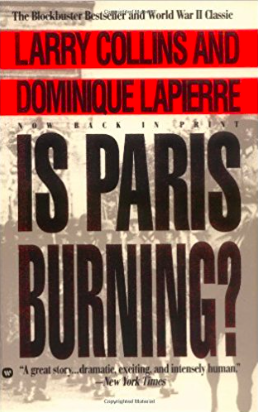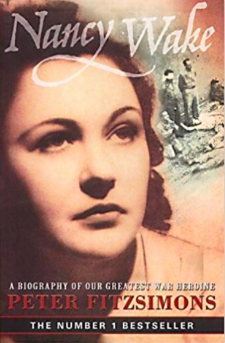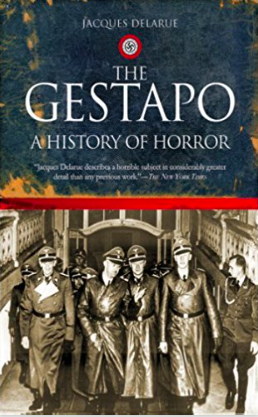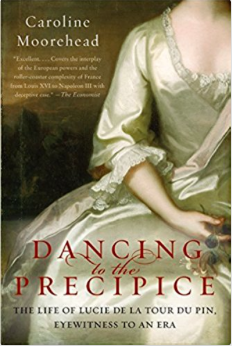Nancy Wake (1912–2011) was someone you don’t ever forget. Her personality, exploits, and courage will stick with you long after reading this book.
The bibliography is a short one. The author didn’t need a whole lot of reference material because several books on her biography were already in print, Nancy’s memoirs were published in 1985 (The White Mouse), and a series of personal interviews with Nancy were completed before she passed away. Despite the many renditions of her wartime stories, this was a book that I couldn’t put down. This story has everything a Hollywood movie needs to be a hit (several foreign made television mini-series were made). These are episodes that would have made the Movietone News reels during the war if Nancy’s stories hadn’t been classified secret.
This was one remarkable woman. Read more…….
Who needs to read a Stephen King horror novel when you can curl up in bed and read this book? The horrible things committed by the Gestapo as described by M. Delarue will make any decent person’s skin crawl.
I purchased this book because of its extensive coverage of the Gestapo in Paris during the Occupation. As you will find out in my new book Where Did They Put the Gestapo Headquarters? that by mid-1942, the Gestapo ruled Paris through terror, intimidation, and executions. They took over virtually the entire street called Avenue Foch in the sixteenth arrondissement (district). Additional sub-stations and offices were scattered throughout the city. A knock on one’s door during the evening was cause for concern. If you were Jewish or one of the “undesirables,” you were likely facing the Gestapo (or one of their representatives such as the French police) and deportation to Auschwitz (and certain death) was inevitable. Read more…..

![]() Published right about the same time my family moved to Europe, Collins and Lapierre’s book is a classic on World War II and specifically, the events of liberation as they unfolded in Paris during August 1944. The title is reportedly the question Hitler asked of his Commander of Greater Paris, General Dietrich von Choltitz. Upon appointing von Choltitz as the military governor on 9 August 1944, Hitler gave his general the instructions—known as the “Nero Decree”—to level Paris.
Published right about the same time my family moved to Europe, Collins and Lapierre’s book is a classic on World War II and specifically, the events of liberation as they unfolded in Paris during August 1944. The title is reportedly the question Hitler asked of his Commander of Greater Paris, General Dietrich von Choltitz. Upon appointing von Choltitz as the military governor on 9 August 1944, Hitler gave his general the instructions—known as the “Nero Decree”—to level Paris.
The writers created a fast moving and absorbing story with multiple plot lines. It’s no wonder the book became a popular movie. The book begins with the city when “this warm August morning marked the 1,503rd day of its German occupation.” On or about 12 August 1944, events were triggered that resulted in the liberation of Paris thirteen days later. The domino effect of the events quickly set off the frenzy of the Resistance, diplomatic efforts by the Swedish consulate to save the city, and feverish requests to Eisenhower by the Free French Forces under General de Gaulle for Allied troops (including French troops) to enter the city. Read more….
One of the criteria I have for awarding five stars is that I can’t put the book down. I normally read four to five books at a time, moving from one to another with relative ease. However, there are books that I start and finish without diverting my attention to any other book. This is one of those.
How can I simply describe the Mitford family and in particular, the six daughters? I suppose the best way to paint that picture is to compare them to a famous family of our era: the “Kardashian Family”—but only worse. This English family was best known for the daughters with their political views (and circle of friends) shaped by World War II and the Soviet Union.
Jessica Mitford (1917–1996)—aka Decca—was a card carrying Communist who wrote a best selling book about death. Deborah Mitford (1920–2014)—aka Debo—married a duke and lived out her life as the Duchess of Devonshire. She was the peacemaker between the squabbling sisters. Nancy Mitford (1904–1973) became a best selling author (she wrote an acclaimed biography of King Louis XIV) and lived in Paris her entire adult life. Nancy was renown for her wit and intelligence. Compared to her sisters, Pamela Mitford (1907–1994) lived a relatively private and uneventful life . . . she became a farmer. The antics of the two remaining sisters, Unity Mitford (1914–1948) and Diana Mitford (1910–2003), grabbed the majority of the British and world headlines.
Unity became infatuated with Adolf Hitler and soon worked her way into his small group of friends. Read more….
Let’s put this out there right away—this is a very long book. But don’t let the length of this book dissuade you from reading it. If you’ve ever wanted a comprehensive account of the behind-the-scenes operations of the Allied headquarters, this is it. The various personalities as well as the political and strategic struggles that Eisenhower and his staff experienced are well documented in this book. Frankly, I couldn’t put the book down.
The author wrote a previous book on Smith that was based on his PhD thesis. It’s rare that an author will write a second biography on the same person but Mr. Crosswell felt that he could do a more in-depth look at Smith’s life, in particular when he was chief of staff to Eisenhower. I liked the way the author started the book out.
The “normal” biographical format is for the chronology to begin with the subject’s birth, childhood, and early years before transgressing into the part of their life that brought them fame (at least enough fame to be the subject of a book). Mr. Crosswell begins Smith’s saga after the end of World War II when he served two presidents: as Truman’s ambassador to the Soviet Union and director of the Central Intelligence Agency; then as Eisenhower’s undersecretary of state and key advisor to the president. Read more….
Ever since standing on the Place de la Concorde in Paris as a ten-year-old boy, I’ve been fascinated by the French Revolution. My first two books titled Where Did They Put the Guillotine? were about the French Revolution. As part of the research on those books, I always enjoyed reading contemporary accounts of an author’s experience during those tumultuous years.
So you can imagine my excitement when I ran across Grace Dalrymple Elliott. Grace was a courtesan who had many affairs with the celebrities of their day. Read more…..
It is rare when a historian has the depth and breadth of contemporary written material to draw their written picture of the historical events or persons they are focusing on. Lucie de la Tour du Pin (1770–1853) provided the author with that type of material allowing for a comprehensive and fascinating biography. Through Lucie’s memoirs and her prolific letter writing, we are taken down Lucie’s interesting life’s journey beginning with her position as Marie Antoinette’s lady-in-waiting. Her friends and contacts over her lifetime reads like a “who’s who” from the time of the French Revolution through the mid-19th century.
Lucie and her husband barely escaped the blade of the guillotine by emigrating to the United States where they lived (and farmed in rural New York) until Napoléon became emperor and it was safe to return to France—both of their fathers were beheaded during the “Terror.” Read more….
In the course of researching my new book Where Did They Put the Gestapo Headquarters? I quickly learned of the historical significance of many Paris hotels. Most of these were built during the Belle Époque period (1871–1914) and are grand buildings. On 14 June 1940, the Germans quickly requisitioned them for their various divisional headquarters, administrative offices, and living quarters.
Since there are very few books written about specific Paris hotels, you can imagine my glee when I run across one. There is a book written by Tilar Mazzeo called The Hotel on Place Vendome. It is the story about the Hôtel Ritz and its role during the Occupation. I was very excited to find this potential reference source for one of the sites you will stop at in my new book. That is until I read the reviews. There were glaring historical mistakes as pointed out in detail by several of the reviewers. I couldn’t trust the content so I never purchased the book.
Unfortunately I cannot rate Paris Hotel Stories, a visually beautiful coffee-table book, any higher than one star. After reading several historical inaccuracies, I determined I could not rely on its content. Read more…..
Copyright © 2022 Stew Ross









